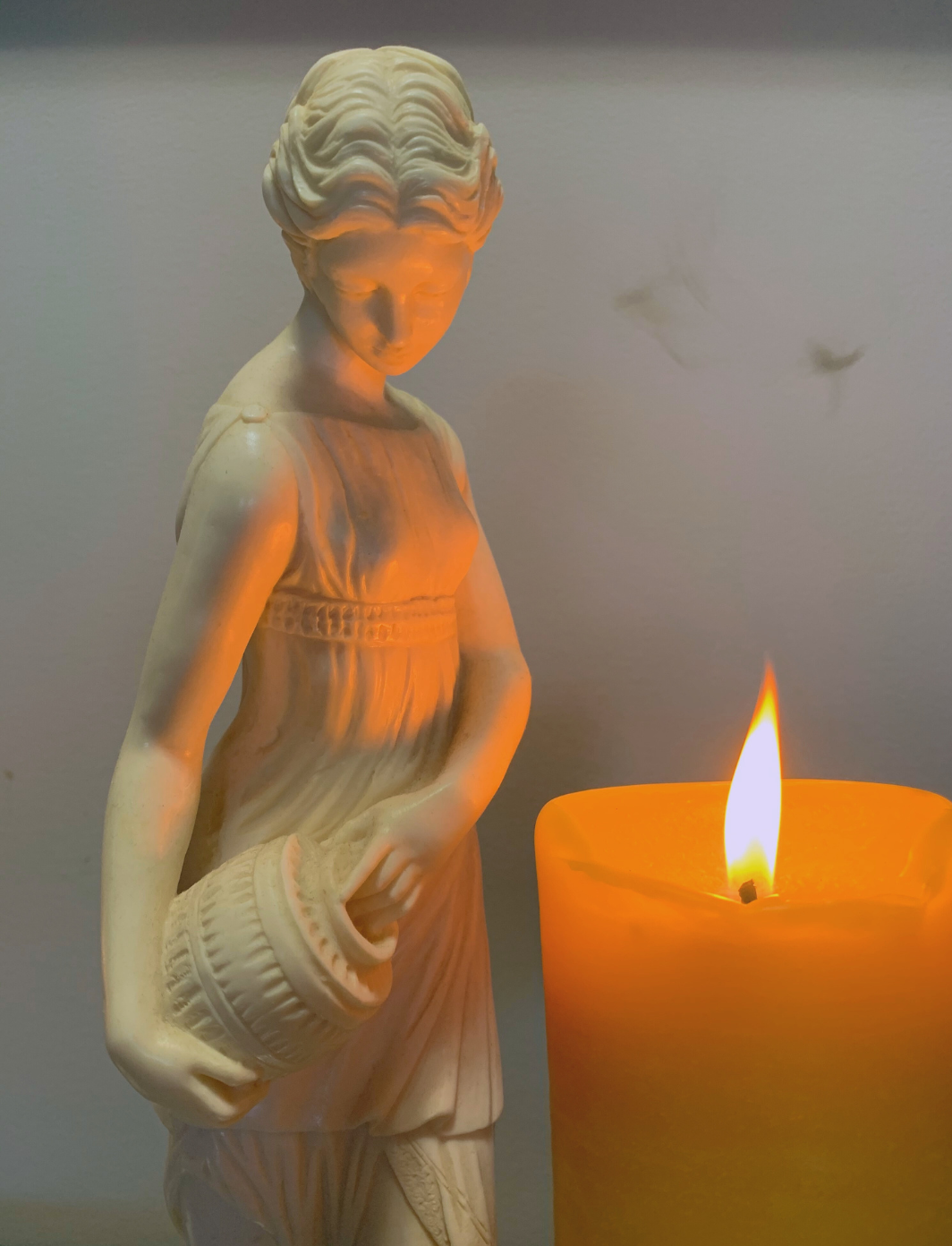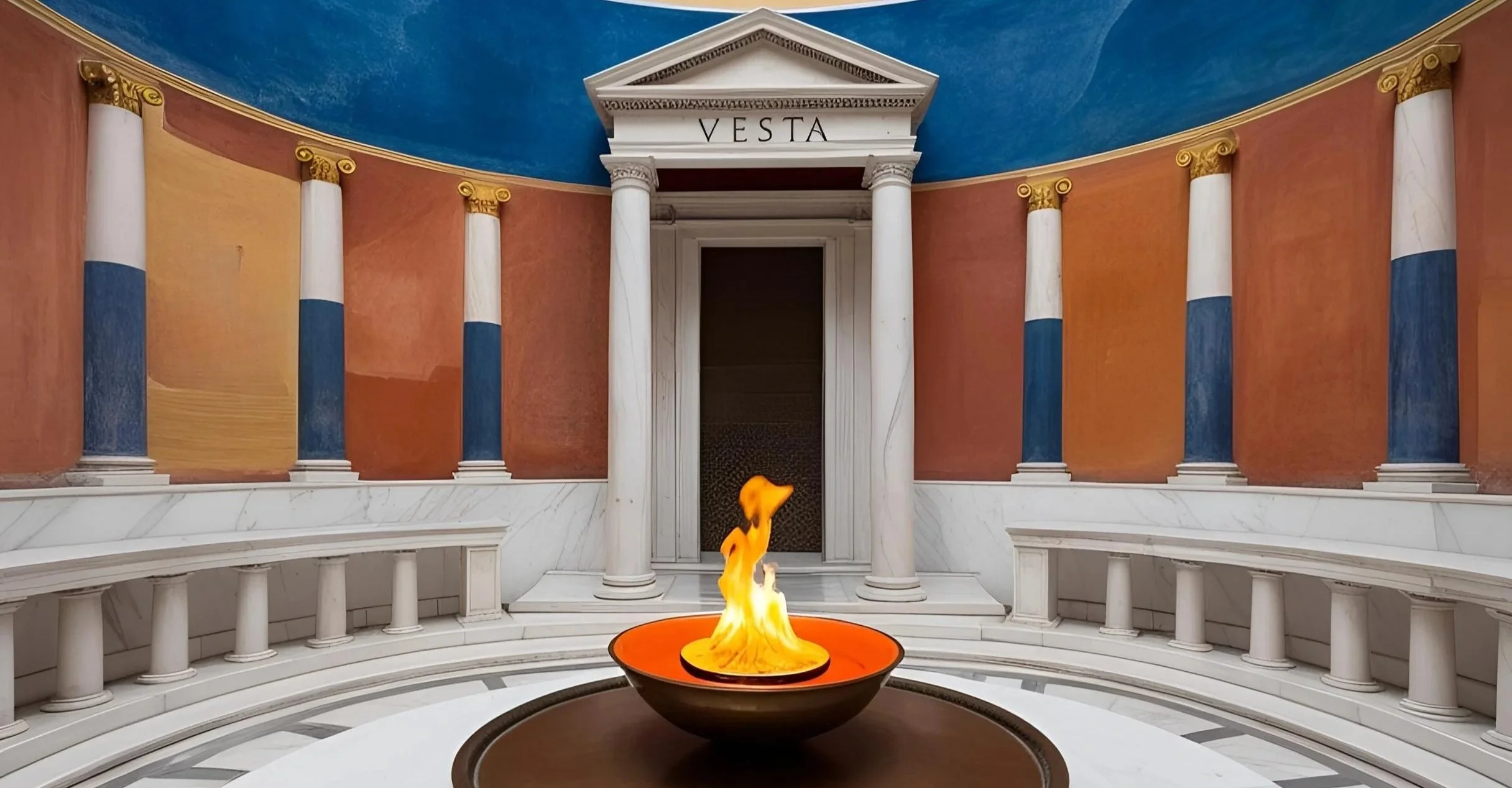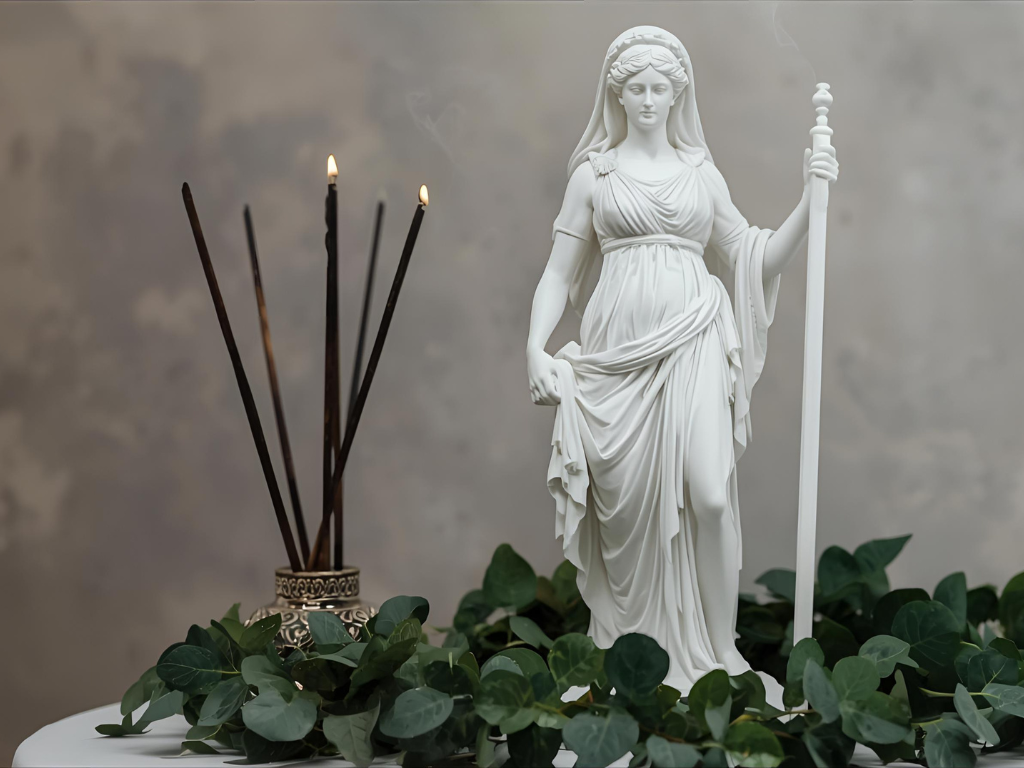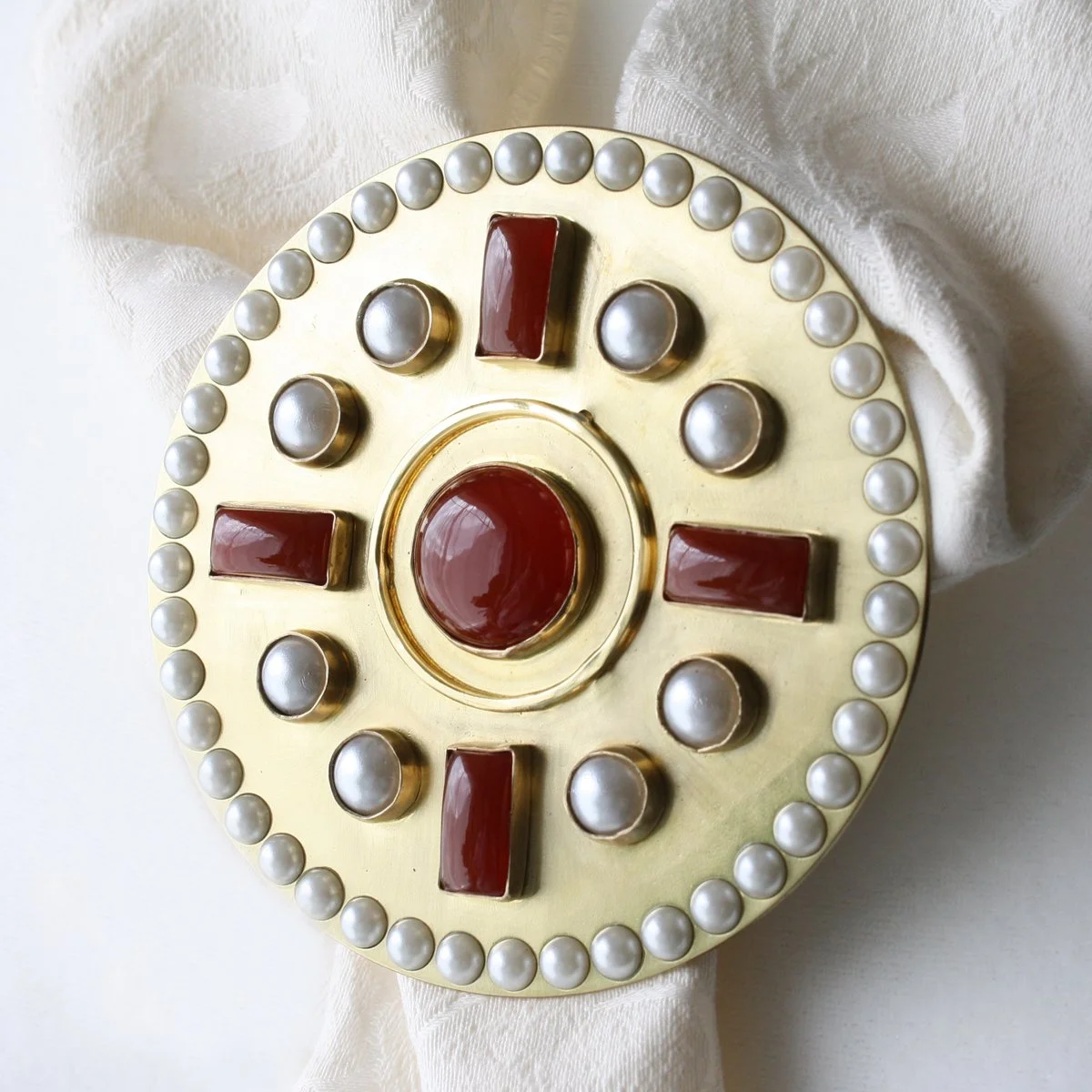
VESTA TODAY
Do You Feel Drawn to the “Old Ways”? Does a Flame Bring You Peace of Mind?
Perhaps aspects of ancient religions, or what you’ve found on this site or read in my books, has appealed to you on a deeper level. I’ve had many people say, “I had to burn a candle while I was reading!” Perhaps, like them, you’ve always felt a natural sense of well-being, reverence or inspiration when you look into a flame, but you’re missing a sense of structure to express or expand upon those feelings.
If so, you’re not alone. Vesta’s eternal flame dates back many centuries, from distant antiquity to this very day. Its focus and rituals have adapted over the years to keep pace with the changing times, and many people, especially those who identify as “spiritual but not religious” or who embrace so-called neo-pagan beliefs, burn it in their homes: the Old World is indeed meeting the New World. In fact, Vesta has returned to its origins as a personal, home-based tradition that provides a natural spiritual focus – fire. Light it for comfort and inspiration. It’s worked for millions of people for millennia. Here are a few ideas to get started.
A Lararium
A lararium or household shrine can be located anywhere in the home, but it is usually located near the entrance to bless the comings and goings of those who live there.
It also serves as a visual reminder that home really is where the heart is. That is true whether you live alone, with family or with your pets.
In terms of style, your lararium can be Classical or modern, hand-made or manufactured.
Some people prefer their lararium to stand out from the home’s décor, while others prefer that it blend in.
You may wish to place a statuette of Vesta on your lararium, whether modern, Classical or ancient. It can be marble, alabaster, bronze or terracotta.
Because the ancient temple was dressed in laurel, you should put greenery, fresh flowers or even a small herb garden that contains a bay plant on your lararium.
Your lararium can hold mementoes of family members, living and dead, as well as sentimental items. You will also place other items on your lararium, such as a beeswax candle, offerings and libations (more on each of these in turn, below).
Regardless of where you place it or what you put upon it, be sure to create a lararium that is “you”. It should make you feel happy and comforted whenever you look at it. But most importantly, it should give you a spiritual focus to honor Vesta in all the ways you will come to know.
A Special Vestal Candle
Because Vesta resides in the flame, a pure amber beeswax candle that represents her sacred flame should be placed in a prominent position on your lararium.
Beeswax candles are preferable. This is because beeswax was typically used for candles by the ancients. Also, burning beeswax releases negative ions into the air, which in turn purifies the air. And Vesta is a purifying spirit.
If you do choose beeswax for your primary Vesta-dedicated candle, you should ensure that it is pure beeswax (not cut with soy or paraffin) for the best and purest burn. You should also ensure they are ethically sourced.
You can use a round, clear glass container to hold the flame, a tribute to the circular temple that once housed the sacred fire. If using a pillar candle, you can carve a ‘V’ into the wax to dedicate it to Vesta.
Ideally, you will use a candle with a wood wick that crackles when it burns, a sound the ancients believed was Vesta speaking.
Offering to Vesta
In antiquity, mealtime and prayer offerings of bread or loose salted-flour were tossed into the household hearth or sprinkled directly into the sacred flame.
Doing so is an ancient way to connect with the goddess. An alternative is to place offerings in a bowl near your candle. This ensures a pure, clean and safe burn, while preserving your candle.
You can make these symbolic offerings to the sacred flame at mealtime, as well as during meditation, prayer or times of reflection.
You can also use the same kind of salted-flour wafers that the Vestals used to use for offerings and rituals. These can be created by mixing flour, salt and water and baking in the oven for a few moments. These wafers can be passed – cleanly and safely – over the flame as an offering to Vesta.
Libations to Vesta
A libation is a liquid offering. The decision of whether to make an offering or a libation is a matter of personal choice. Both the ancients, and people today, do both. The Vestals would have used one, the other, or both in a particular way for each particular purpose or ritual.
In antiquity, a libation of olive oil, milk or wine was sprinkled into the sacred fire in the hearth or in a candle’s flame. (Again, you may wish to place the libation in a bowl near your candle. This will preserve the wax, which is important for reasons you will read about below.)
Igniting Awareness
Fire has long symbolized eternity and the soul.
Fire worship—including the deification of fire and flame-centered rituals—is the oldest form of spiritual expression we know, and it continues today.
A simple ritual involves burning a beeswax candle in a dark, quiet room, while focusing on the sun-like glow (which is particularly strong with beeswax candles) of the flame and the fragrance of the beeswax.
Since burning beeswax stimulates the pituitary gland, which enhances intuition, this is a beautiful way to find greater self-awareness - and is another reason your Vesta candle should be pure beeswax.
Candle Reading by the Flame of Vesta
Just like reading the stars, reading the flame and wax drippings of a Vesta-dedicated candle can help you find answers to life’s many questions.
It can help you reflect upon your past, present and future, so that you can live a truly illuminated life.
Visit the Candle Reading page to learn more about this insightful, fun and meaningful practice.
You can also consider one of my Custom Vesta Candle Readings if you’d like me to perform a candle reading ritual on your behalf.
Relaxing Candle Burns
We all need to take time for ourselves each day to relax.
These candle burns - each of which embodies aspects of a Roman god - provide a wonderful focus to help you do that, while also exploring aspects of your own life, from love to finances.
Click here to learn more and watch these videos
Observe Meaningful Dates from Antiquity
The Ancient Romans had a plethora of religious festivals that honored the gods. Two of the most important events that honored Vesta took place on March 1st and June 7 to 15.
March 1st was the date on which the Vestal priestesses ceremonially extinguished and then relit Vesta’s sacred fire in the temple. This is a great day to think about new beginnings.
June 7 to 15 encompassed the Vestalia, or the festival to Vesta. During this celebration, the inner sanctum of the temple was opened for women to enter and both observe and offer to the sacred hearthfire. On June 15, the temple was ceremonially cleaned. This period is therefore ideal for any cleaning or purifying that needs to happen in your life.
Read a Book
Immersing yourself in the ancient world, where Vesta’s fire first burned, is a powerful way to experience the history and rituals of the Vesta religion in an authentic, emotional way. It can certainly help you develop insight and a sense of reverence for it.
My historical fiction novels are a good place to start. The one pictured here (Coelia Concordia: The Last Vestal Virgin of Rome) is my seventh novel about the Vestals.

Star-Gazing
The temple of Vesta in the Roman Forum was designed in a circular shape to represent the orb of the sun, our planet’s star, as the source of all life.
You may wish to spend more time doing what the ancients did – looking up, into the sky, especially the night sky, to wonder at the universe (this V symbol, for example, is the symbol for the asteroid called Vesta). Locate the constellations and learn the Greco-Roman myths behind their names.
Also don’t forget that when you look up, you’re seeing the immortal gods. Mercury, Venus, Mars, Jupiter, Saturn… the ancient Romans named the planets after the gods, and some are visible with the naked eye.
Learn Myths & Legends
Nobody told a story like the ancient Romans – except maybe the Greeks before them!
Read about the ancient myths and legends the Vestals knew so well, and that we still tell today, from the Birth of Venus to the Fall of Troy.
In this painting, Perseus is confronting Phineus with the head of the Gorgon Medusa. Those who set eyes on it are turned to stone.
Burning Incense
While most images or relief carvings we have of the Vestal Virgins show them tending to the sacred fire or making an offering into the flames, we know that the Vestal priestesses also burned incense to please the goddess with its fragrant smoke.
You can do the same. Frankincense was commonly used in religious rituals by the ancient Romans, as were imported incenses.
The Vestals also used other strongly fragranced items, like pinecones. That being the case, experiment with differently fragranced incenses to see which one seems to bring you the best fortune.
Let the Light Soothe You
A candle’s flame has always been a natural source of comfort. You can tap into that simple truth by just slowing down, taking some time for yourself, and burning a candle while you do.
A little self-care by candlelight (the pink flower petals in this picture allude to the pink roses that currently grow in the ruins of the House of the Vestals) can go a long way to soothe your spirit.
A Personal Symbol
As you can see, red carnelian stones (representing the sacred fire) are arranged in a pagan cross formation. The central stone represents Vesta’s fire as the sun in the center, and the four rectangular stones represent the cardinal directions (north, south, east, west), as if Vesta’s fire is illuminating the whole world. The white pearls represent the Vestal priestesses tending to the sacred fire in the middle. If you want, you can follow this great Vestal’s lead and choose red and white gemstones or a pagan cross. My point is, you don’t have to stick to a simple V-shaped pendant—unless you want to! Enjoy finding a symbol that has meaning to you. (By the way, you’ll find a video on how I had this Vestal’s medallion recreated on the Videos page.)
And remember that your personal symbol can go beyond jewelry. Wearing the color white—whether a simple T-shirt or a scarf—can work too. If you’re interested in a few other fun ways to carry Vesta with you as you go through your day, you might want to check out the All Things Vesta Store. Click here to visit it.
The adherents of most religions wear some kind of personal symbol to reflect their faith, and those who honor Vesta and the old gods are no different. The personal symbol you choose should be just that—personal. You should wear whatever resonates with you and makes you feel connected to Vesta.
Some people like to wear ancient-styled jewelry, such as a glass-bead or gold necklace, brooch, pendant or bracelet. Affordable reproduction Roman jewelry is very beautiful and widely available for both women and men. Men in particular seem to like rings, especially intaglio rings with an image of Vesta engraved in the stone or soldier’s rings.
The photo I’ve included here is a reproduction I had made of a medallion worn by the late 4th century Vestalis Maxima Coelia Concordia (as depicted in a 16th century illustration of her excavated statue). You may wish to take some inspiration from it.
Spread the Flame
If you want to fill your home with Vesta’s glow and feel like you’re connecting with history and other like-minded people, check out the Spread the Flame page. You’ll learn more about my experience with Vesta and how I use candles and pre-burned Vestal wooden wicks to spread the flame… and how you can too!
















